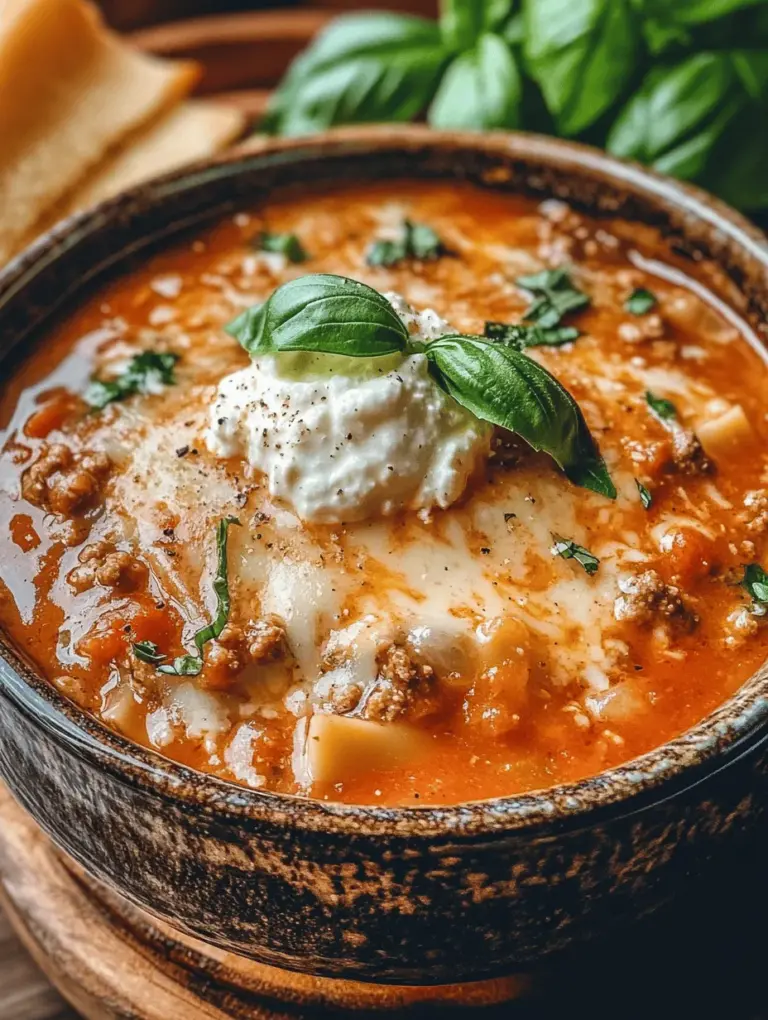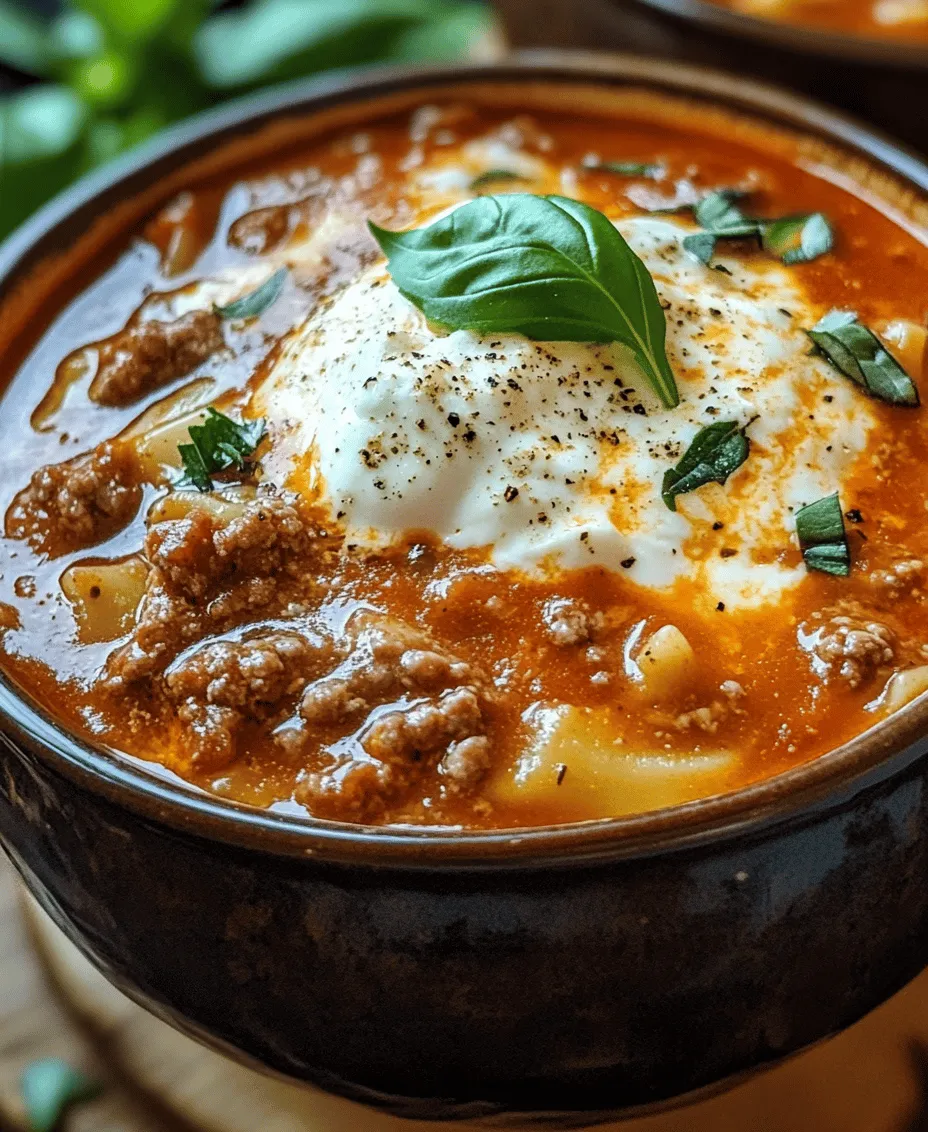Introduction
Lasagna soup is the epitome of comfort food, bringing together the beloved flavors of traditional lasagna in a cozy, bowl-friendly format. Imagine the rich, savory layers of pasta, tangy tomato sauce, and gooey cheese, all wrapped up in a warm, hearty broth. This dish not only satisfies your cravings for Italian cuisine but also provides a delightful twist that makes it perfect for any occasion. Whether you’re looking for a filling dinner option to warm you up on a chilly evening or a dish to impress guests at a gathering, lasagna soup checks all the boxes.
In recent years, one-pot meals have surged in popularity, and for good reason. They not only simplify the cooking process but also minimize cleanup, making them ideal for busy weeknights when time is of the essence. This lasagna soup recipe fits seamlessly into that trend, allowing you to whip up a delicious meal in under an hour without sacrificing flavor or comfort. With just one pot and a handful of ingredients, you can create a dish that brings the family together around the dinner table, and the best part is that it’s incredibly easy to customize to suit your taste preferences.
Whether you’re a novice cook or a seasoned chef, this lasagna soup recipe is designed to be straightforward, quick, and deeply satisfying. Let’s dive into the key ingredients that make this dish truly special.
Understanding the Ingredients
Before we start cooking, it’s essential to understand the ingredients that will come together to create this delicious lasagna soup. Each component plays a vital role in building flavor, texture, and overall satisfaction.
Ground Beef or Italian Sausage
The choice of protein in lasagna soup is crucial, as it forms the foundation of the dish’s heartiness. Ground beef is a classic option, providing a rich flavor that pairs perfectly with the other ingredients. Alternatively, Italian sausage—whether sweet or spicy—can add an extra depth of flavor with its blend of herbs and spices. The aroma of browned meat wafting through your kitchen is sure to set the stage for a delightful meal ahead.
Onion and Garlic
No savory dish is complete without the aromatic duo of onion and garlic. Sautéing these ingredients at the beginning of the cooking process helps to develop a flavorful base, enhancing the overall taste of the soup. The sweetness of the onions combined with the pungent, earthy notes of garlic creates a harmonious blend that elevates the dish from simple to sensational.
Tomatoes
When it comes to tomatoes, you have several options: crushed tomatoes, tomato sauce, or diced tomatoes. Each type contributes a different texture and flavor profile to the soup. Crushed tomatoes are often favored for their smooth consistency and rich flavor, making them an excellent choice for this recipe. Tomato sauce can add a slightly sweeter taste, while diced tomatoes provide a chunkier texture. The choice ultimately depends on your personal preference, but don’t underestimate the impact of quality tomatoes on the final dish.
Broth
Choosing the right broth is essential for achieving a rich and satisfying soup. Both chicken and vegetable broth are excellent options, each bringing its own unique flavor. Chicken broth tends to offer a slightly more robust taste, while vegetable broth provides a lighter, herbaceous note. Either way, the broth serves as the canvas for the other ingredients to mingle and develop depth.
Lasagna Noodles
One of the standout features of lasagna soup is the use of broken lasagna noodles, which adds a delightful texture to the dish. By breaking the noodles into smaller pieces, you make them easier to consume in soup form while ensuring they absorb the flavors of the broth and other ingredients. This method also eliminates the need for traditional layering, making the cooking process more efficient.
Herbs and Spices
Herbs and spices are essential for bringing the soup to life. Oregano and basil are classic Italian herbs that pair beautifully with the tomatoes and meat. They infuse the dish with aromatic notes that evoke the essence of traditional lasagna. If you enjoy a bit of heat, consider adding optional red pepper flakes to give your soup an extra kick.
Cheese
No lasagna would be complete without cheese, and this soup is no exception. Ricotta, mozzarella, and Parmesan all play vital roles in achieving that creamy, indulgent texture we crave. Ricotta adds a rich creaminess, mozzarella provides that gooey, melting quality, and Parmesan offers a sharp, salty finish. Together, these cheeses work in harmony to create a decadent topping that rounds out the dish perfectly.
Preparation Steps Explained
Now that we’ve covered the essential ingredients, it’s time to dive into the preparation steps for making the BEST lasagna soup. Each step is designed to build flavor and ensure you achieve the perfect consistency.
Cooking the Meat
The first step in preparing your lasagna soup is to cook the ground beef or Italian sausage. Start by heating a large pot over medium-high heat. Once hot, add the meat, ensuring not to overcrowd the pan. Browning the meat is critical, as it caramelizes the sugars and enhances the flavor profile. Use a wooden spoon to break the meat apart, allowing it to cook evenly. Once browned, drain any excess fat to keep the soup from becoming greasy.
Sautéing Aromatics
After the meat is cooked, it’s time to add the aromatics. In the same pot, add a drizzle of olive oil if needed and toss in the chopped onions. Sauté them for about 2-3 minutes until they become translucent and fragrant. Then, add the minced garlic and continue to sauté for an additional minute. Be careful not to burn the garlic, as it can turn bitter quickly. This step is vital for developing the base flavors of your soup.
Adding Liquids and Simmering
With the meat and aromatics prepared, it’s time to add the liquids that will form the heart of your soup. Pour in your choice of broth, followed by the crushed tomatoes. Stir well to combine, scraping up any browned bits from the bottom of the pot to ensure all flavors are incorporated. Bring the mixture to a gentle simmer, allowing the flavors to meld together for about 10 minutes. This simmering process is crucial, as it allows the ingredients to marry and creates a rich, flavorful broth.
As we continue with the preparation, we’ll discover how to incorporate the lasagna noodles and cheese, bringing our hearty soup to life. Stay tuned as we explore the final steps to create this comforting dish that is sure to become a family favorite.
Incorporating the Noodles
When it comes to lasagna soup, the noodles play a pivotal role in achieving that signature hearty texture. The best way to incorporate the noodles is to cook them separately until they reach al dente, which means they should be firm to the bite. This ensures that they maintain their texture even after being combined with the soup.
Timing is Key: Add the noodles to your boiling broth just a few minutes before serving. This way, they will absorb the flavors of the soup without becoming mushy. Typically, cooking the noodles for about 4-5 minutes in the broth is sufficient. If you prefer to cook them in advance, be sure to undercook them slightly, as they will continue to soften when combined with the hot soup.
Texture Considerations: For a delightful bite, consider using traditional lasagna noodles broken into pieces, or opt for smaller pasta shapes like fusilli or rotini. These alternatives will still capture the essence of traditional lasagna while making the soup easier to enjoy.
Preparing the Cheese Mixture
The cheese mixture is a star component of lasagna soup, bringing creaminess and richness that elevates the dish. Traditionally, ricotta cheese is used, but feel free to customize this mixture to suit your taste.
Texture and Flavor Profile: Start by mixing ricotta cheese with a beaten egg to help bind the ingredients and add a touch of creaminess. Incorporate freshly grated Parmesan cheese for a nutty flavor and a sprinkle of salt and pepper to taste. For added depth, consider blending in some fresh herbs like parsley or basil. These herbs not only enhance the flavor but also add a fresh element that balances the richness of the cheese.
For a delicious twist, you can introduce other cheeses such as mozzarella or goat cheese into the mixture, which will melt beautifully into the soup when served. Whipping this cheese blend until smooth ensures a velvety texture that complements the robust flavors of the soup.
Serving and Presentation
Presentation can elevate the dining experience, so consider the following suggestions for plating your lasagna soup.
Visual Appeal: Serve the soup in deep bowls to highlight its hearty nature. Ladle a generous portion of soup into each bowl, ensuring that everyone gets a good mix of noodles, meat (if using), and broth. For an eye-catching finish, dollop a spoonful of the cheese mixture on top of each serving. This not only adds a beautiful contrast but also invites diners to stir the cheese into the soup, creating a delightful creaminess.
Garnishing: The final touch to your lasagna soup should be a garnish of fresh basil leaves and a sprinkle of additional grated cheese, such as Parmesan or mozzarella. The vibrant green of the basil adds a pop of color, while the cheese melts slightly into the hot soup, creating an inviting and aromatic dish.
Serving Options: While deep bowls are ideal for the soup, consider serving it alongside crusty garlic bread or a light salad for a well-rounded meal. The bread is perfect for dipping, while the salad adds a refreshing contrast to the rich flavors of the soup.
Nutritional Information
Lasagna soup not only satisfies the taste buds but also provides a range of nutritional benefits.
Protein and Carbohydrates: Each serving of lasagna soup offers a balanced mix of protein from the cheese and meat, alongside carbohydrates from the noodles. This combination makes for a filling meal that can keep you energized throughout the day.
Healthy Fats: If you incorporate olive oil in your broth or a sprinkle of cheese on top, you also introduce healthy fats, which are essential for a well-rounded diet.
Caloric Breakdown: A typical serving of lasagna soup contains around 300-400 calories, depending on the ingredients used and portion size. For those looking to lighten the dish, consider reducing the amount of cheese or using leaner cuts of meat. Alternatively, you can substitute some of the noodles with vegetables, such as spinach or zucchini, to lower the caloric content while boosting nutritional value.
Modifications for Healthier Versions: For a healthier rendition, opt for whole-grain noodles to increase fiber content, or switch to low-fat cheese options. You could even make the soup vegetarian by using lentils or chickpeas as a protein source.
Variations and Customizations
One of the joys of cooking is the ability to adapt recipes to suit diverse tastes and dietary preferences. Lasagna soup is no exception.
Vegetarian Options: For those who prefer a vegetarian version, consider replacing the meat with hearty vegetables like mushrooms, zucchini, or lentils. These ingredients provide excellent texture and absorb the flavors of the broth beautifully.
Gluten-Free Alternatives: If gluten is a concern, use gluten-free pasta options available in most supermarkets. Alternatively, spiralized zucchini or butternut squash can serve as a delicious, low-carb substitute, transforming the dish into a vegetable-centric delight.
Dairy-Free Modifications: For those avoiding dairy, there are plenty of cheese substitutes available. Cashew cheese or tofu ricotta can be blended to create a creamy texture without the lactose. Additionally, nutritional yeast can add a cheesy flavor to the soup, enhancing the overall taste profile.
Conclusion
Lasagna soup encapsulates the warmth and comfort of traditional lasagna while offering a convenient and quick meal option. Its hearty nature and rich flavors make it perfect for serving during family gatherings or cozy nights in, where sharing a pot of soup fosters connections and creates lasting memories.
As you explore this recipe, don’t hesitate to experiment with variations that cater to your palate or dietary needs. Whether you choose to stick with the classic recipe or venture into creative adaptations, this lasagna soup is bound to become a favorite in your household. So gather your ingredients, invite loved ones to the table, and enjoy the communal experience of sharing a delicious, homemade meal.



